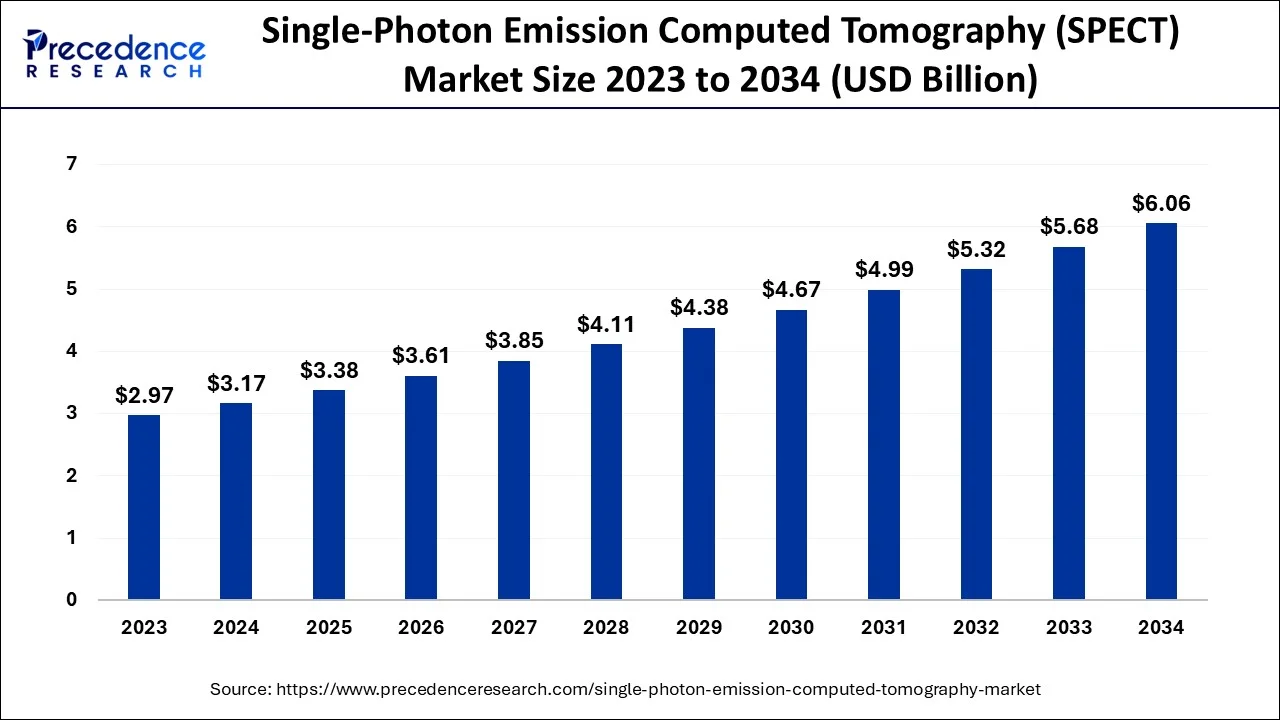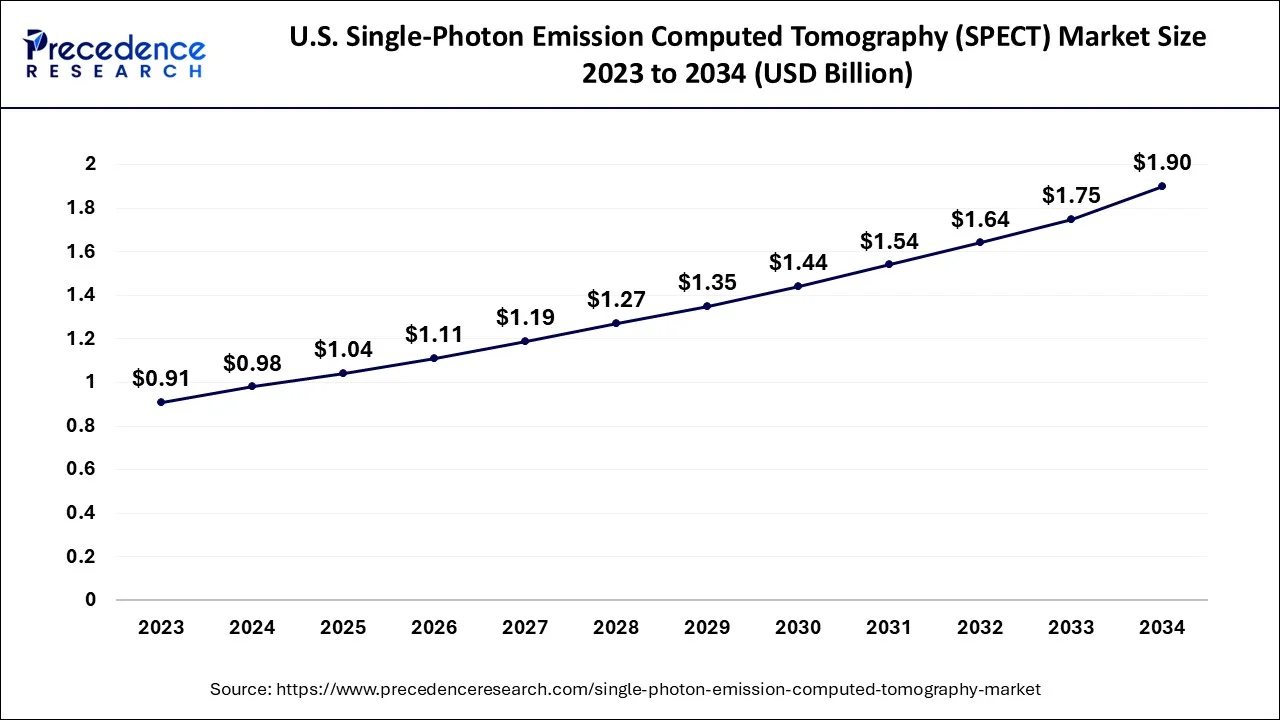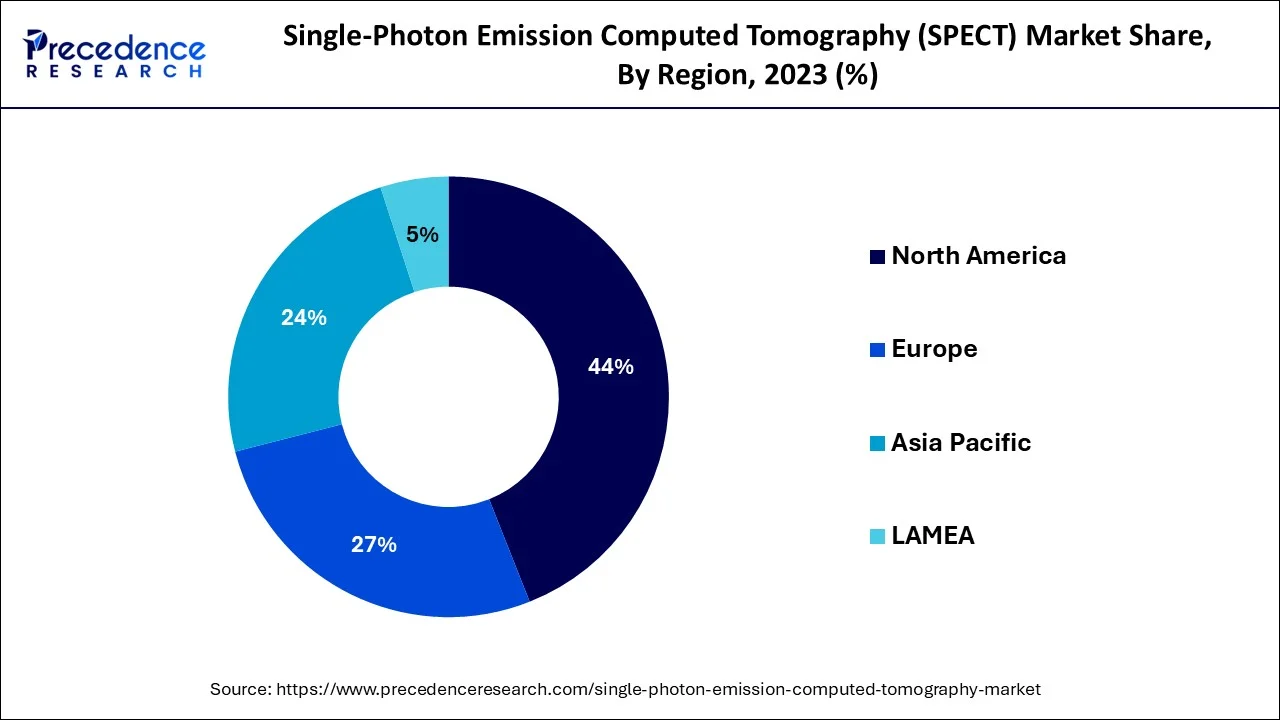List of Contents
Single-Photon Emission Computed Tomography (SPECT) Market Size and Forecast 2024 to 2034
The global single-photon emission computed tomography (SPECT) market size is estimated at USD 3.17 billion in 2024 and is anticipated to reach around USD 6.06 billion by 2034, expanding at a CAGR of 6.69% from 2024 to 2034. Advancements in radiopharmacy to boost the growth of the global single-photon emission computed tomography market.

Single-Photon Emission Computed Tomography (SPECT) Market Key Takeaways
- By geography, the North America region dominates the global market.
- By type, the hybrid SPECT systems segment is predicted to grow at a remarkable CAGR from 2024 to 2034.
- By product, the single imaging gamma cameras segment holds the maximum revenue share in 2023.
- By application, the cardiology segment holds the largest revenue share in 2023.
- By end-user, the hospital segment contributed the major revenue share in 2023.
U.S. Single-Photon Emission Computed Tomography (SPECT) Market Size and Growth 2024 to 2034
The U.S. single-photon emission computed tomography (SPECT) market size is estimated at USD 0.98 billion in 2024 and is expected to be worth around USD 1.90 billion by 2034, rising at a CAGR of 6.92% from 2024 to 2034.

North America dominates the global market. The rapidadoption of advanced imaging technology by the healthcare sector in North America is considered a major driving factor for the growth of the market. The growth of the SPECT market in the region is driven by the growing number of discoveries of new radiopharmaceutical devices for computed imaging. Increasing cases of cancer and cardiovascular disorders in recent years have boosted the demand for effective molecular imaging SPECT scanners. The U.S. and Canada are considered as largest contributors to the growth of market owing to the presence of well-established healthcare as well as radiopharmaceutical industries. Europe acquires a significant revenue share of the single-photon emission computed tomography market. Growing investment in advanced diagnostic centers in the region is propelling the growth of the market.

Asia Pacific is the fastest growing region in the global single-photon emission computed tomography market. Growing expenditure in the healthcare sector is the major driver for the growth of the market in Asia Pacific. Growing population in countries such as China and India and growing radiopharmaceutical industry in the region are factors that fuel the growth of single-photon emission computed tomography market.
Market Overview
Single-photon emission computed tomography (SPECT) test is used in preclinical applications to detect the blood flow in the body. The technique also helps to diagnose disease/disorder with the help of imaging. SPECT provides 3D activity of blood flow in the body by using short-lived radioisotopes. SPECT offers imaging of internal organs in the human body and allows the tracking of their functions. Single-photon emission computed tomography technique has been a boon for the healthcare industry as it helps healthcare providers to analyze the blood flow in body organs, tissues and bones. SPECT technology uses radioactive substances and gamma cameras in the process of imaging.
A radioactive tracer in the form of a drug is injected into the body to get the SPECT scans done. An appropriate tracer is chosen according to the requirement of the test and depending on the symptoms. Single-photon emission computed tomography scans can be used for a variety of purposes. It is capable of diagnosing numerous cardiac, brain and bones related issues. The technique can also detect the presence and progression of cancer. The SPECT technique carries multiple advantages, such as better& accurate diagnosis and increased specificity.
Market Scope
| Report Coverage | Details |
| Market Size in 2024 | USD 3.17 Billion |
| Market Size by 2034 | USD 6.06 Billion |
| Growth Rate from 2024 to 2034 | CAGR of 6.69% |
| Base Year | 2023 |
| Forecast Period | 2024 to 2034 |
| Segments Covered | By Type, By Product, By Application, and By End-User |
| Regions Covered | North America, Europe, Asia-Pacific, Latin America and Middle East & Africa |
Market Dynamics
The global single-photon emission computed tomography (SPECT) market is expected to experience noticeable growth during the forecast period. Technological advancement in diagnostic applications is seen as a major driver for the growth of the single-photon emission computed tomography market. The significant growth of the overall SPECT market is attributed to the development in the global radiopharmaceutical industry. SPECT scanners are widely used in the diagnosis of cancer. Thus, the increasing prevalence of cancer or other serious health conditions, such as cardiovascular diseases, is propelling the growth of the single-photon emission computed tomography (SPECT) market. The growing demand for advanced imaging techniques for faster diagnosis and treatment purposes is considered as another major driving factor for the growth of the market.
SPECT scanners offer anatomical imaging as well as tissue phenotyping; this is seen as a powerful combined benefit of the technology, which boosts sales. Other factors such as increased research and development (R&D) activities, clinical trials, strategic partnerships and collaboration between major key players, expansion of product portfolio and the invention of combined modality SPECT systems are fueling the growth of the global single-photon emission computed tomography market. The global increase in healthcare expenditure, several favourable government policies and support for the discovery and utilization of innovative SPECT scanners in the healthcare industry and rising number of diagnostic centres for faster and easier diagnosis of disease are a few more factors that contribute to the growth of the market.
However, the lack of skilled professionals is considered to be the major restraining factor for the growth of the global single-photon emission computed tomography market. The high cost associated with the technology and its practices hampers the growth of the market. Along with this, longer scanning time associated with the technique is seen as another restraint. Moreover, technological concerns related to the SPECT modalities discourage the growth of the SPECT market. Factors such as low tissue contrast offered by SPECT technique create limitations for the utilization of SPECT scanners. Furthermore, strict regulatory requirements in several countries hamper the growth of the market.
SPECT scanners and related equipment are expensive. And the purchasing capacity of small-scale healthcare providers for SPECT scanners is low; this factor affects the expansion of the market. Lack of awareness in underdeveloped countries for SPECT techniques and low budget to adopt the technology have hampered the growth of the single-photon emission computed tomography market. The utilization of SPECT scanners exposes both doctors and patients to radiation, which may result in adverse effects on health. This risk has hampered the growth of the market.
Type Insights
Based on type, the global single-photon emission computed tomography market is divided into standalone SPECT systems and Hybrid SPECT systems.The Hybrid SPECT systems segment is expected to grow during the forecast period. Healthcare providers have been seen shifting from standalone to hybrid SPECT modalities in recent years. Hybrid SPECT systems are advanced and offer more clinical utility during the imaging process. The technological advancement and continuous discovery of new hybrid SPECT scanners are contributing to the growth of the segment.
The standalone SPECT systems are still widely used by healthcare providers. Standalone SPECT systems are generally used in oncology segment. However, the rapid adoption of hybrid SPECT systems in hospitals is likely to impact the growth of the standalone SPECT systems segment.
Product Insights
By product, the global single-photon emission computed tomography market is divided into single imaging gamma cameras and SPECT/CT. The demand for single-imaging gamma cameras still remains high as compared to SPECT/CT. The adoption rate of gamma cameras is higher by healthcare providers as they capture both static and dynamic images of targeted body parts of the human body.
Single imaging gamma cameras are widely used in nuclear medicine for functional scanning of the gallbladder, brain and lungs. SPECT/CT offers high resolution images; thus, they are considered to provide more valuable diagnosis. This advantage will drive the growth of SPECT/CT segment during the forecast period of 2024-2034.
Application Insights
By application, the global single-photon emission computed tomography market is divided into cardiology, oncology, neurology and others. In the global single-photon emission computed tomography market, the cardiology segment holds the largest revenue share. A growing number of patients with coronary artery diseases and other heart related diseases has boosted the demand for SPECT scanners from cardiology departments across the globe. Cardiologists use SPECT scanners to check blood flow in the vessels and to identify the exact heart problem that has occurred. The diagnosis or identification of cardiovascular disease is done by injecting a radioactive tracer marked with gamma cameras.
SPECT technique is capable of detecting the insufficient blood flow in the heart, this helps doctors in diagnosis and treatment procedures. Moreover, the increased awareness among people for early diagnosis and heart checkups is contributing to the segment's growth. Considering the overall medical benefits provided by the SPECT, the cardiology segment is projected to witness a noticeable growth during the forecast period. Moreover, increasing numbers of cancer patients has boosted the demand for SPECT scanners. SPECT helps in tracking the spread of cancer.
End-User Insights
By end-user, the hospital segment holds the largest revenue share in the market owing to the increased expenditure on hospitals in the healthcare sector. The growing number of patients being admitted to the hospitals is a major driver for the growth of the hospital segment. The purchasing capacity of SPECT scanners for hospitals is high.
The growth of hospital segment is driven by the increased deployment of advanced imaging technologies in the hospitals. Specialty diagnostic center is the fastest growing segment after the hospital segment. The diagnostic center segment is predicted to grow at a good rate during the forecast period owing to the increased investment in diagnostic centers. Diagnostic centers provide medically advanced imaging applications with trained staff, these factors are boosting the growth of the segment.
Single-Photon Emission Computed Tomography (SPECT) Market Companies
- Mediso Ltd
- Siemens Healthcare AG
- General Electric Co.
- Bruker Co.
- MiE GmbH
- Digirad Corporation
- Spectrum Dynamics Medical Inc
Recent Developments
- In November 2022. GE Healthcare announced that the company has received expanded approval from the U.S. Food & Drug Administration for the use of its GE Healthcare DaTscan in patients with suspected dementia with Lewy bodies.
- In October 2022, Spectrum Dynamics announced its recent development in digital nuclear medicine imaging. New VERITON-CT-400 Series Digital SPECT/CT scanners are capable of imaging high-energy isotopes using solid state detector technology with wide-bore configuration.
- InOctober2022, Punjab Health and Family Welfare Ministry, India, approved the purchase of SPECT/CT, PET/CT scanner for Homi Bhabha Cancer Hospital.
- In June 2022, a leading company in SPECT market, Siemens Healthineers, announced that the company has received approval from the U.S. Food & Drug Administration (FDA) for new SPECT/CT scanner ‘Symbia Pro. Specta SPECT/CT scanner. This new SPECT/CT scanner offers a variety of enhanced capabilities including low dose CT up to 64 slices.
- In May 2022, a global leader in the diagnosis of cancer and other serious conditions, Swansea's Singleton Hospital, received 4.1 million British pound state-of-the-art scanners investment. This investment will be utilized to purchase new SPECT/CT equipment that will help clinicians to spot cancer at early stage.
- In May 2022, a global player in SPECT market, Mediso Ltd announced that the company has planned to acquire Bartec Technologies Ltd. Bartes is a UK based company specializing in supply and installation of molecular imaging equipment and accessories.
Segments Covered in the Report:
By Type
- Standalone SPECT Systems
- Hybrid SPECT Systems
By Product
- Single Imaging Gamma Cameras
- SPECT/CT
By Application
- Cariology
- Oncology
- Neurology
- Others
By End-User
- Hospitals
- Ambulatory Surgical Centers
- Diagnostic Centeres
By Geography
- North America
- Europe
- Asia-Pacific
- Latin America
- The Middle East and Africa
For inquiries regarding discounts, bulk purchases, or customization requests, please contact us at sales@precedenceresearch.com
Frequently Asked Questions
Ask For Sample
No cookie-cutter, only authentic analysis – take the 1st step to become a Precedence Research client